Bulletin – March 2016 Australian Economy Cyclical Labour Market Adjustment in Australia
- Download the article 689KB
Abstract
Since the late 1990s, a larger share of labour market adjustment in Australia has come about via changes in average hours worked, as opposed to changes in the number of people employed. Much of this is likely to reflect that the economic downturns in the 2000s were relatively short and shallow compared with the recessions in the 1980s and 1990s. Had these later downturns been more severe, firms may have needed to shed more workers. It is also possible that labour market reforms over recent decades have provided firms with more scope to reduce labour costs by reducing working hours and wage growth rather than by reducing headcount. Consistent with these explanations, an important driver of cyclical adjustments in average hours during downturns looks to have been reductions in hours worked for employees who remained in the same job, as opposed to changes in the composition of aggregate employment.
Introduction
A firm's demand for labour is derived from the demand for its output. During a downturn, firms can reduce their use of labour by reducing either the number of workers they employ or by reducing the hours worked by their current employees. From an economy-wide perspective, whether this adjustment occurs through the number of employees or average hours worked by each employee has implications for the costs of a downturn. If workers have their hours reduced but remain employed, many of the costs associated with unemployment, such as skill atrophy and reliance on government assistance, are mitigated. The nature of adjustment also has implications for the measurement of spare capacity in the economy. If significant adjustment can occur through average hours then policymakers should monitor alternative measures of spare capacity – such as the underemployment rate, which takes into account whether employees would like to work more hours – in addition to the unemployment rate, which is based on headcount.
A firm's choice of whether to adjust the number of employees or the hours worked by current employees depends on a range of factors. If the cost of hiring and firing workers is non-trivial, then firms may choose to adjust hours rather than make employees redundant. Expectations of future demand are also important, as firms may be more inclined to adjust working hours if the downturn in demand is expected to be relatively short and shallow. Labour market institutions are also relevant. For example, laws and regulations or wage determination processes may provide incentives for firms to adjust the number of employees or the number of hours worked. Graph 1 provides tentative evidence that Australian firms have made use of both types of adjustment, with downturns in total hours worked reflecting declines in both employment and average hours worked.[1]
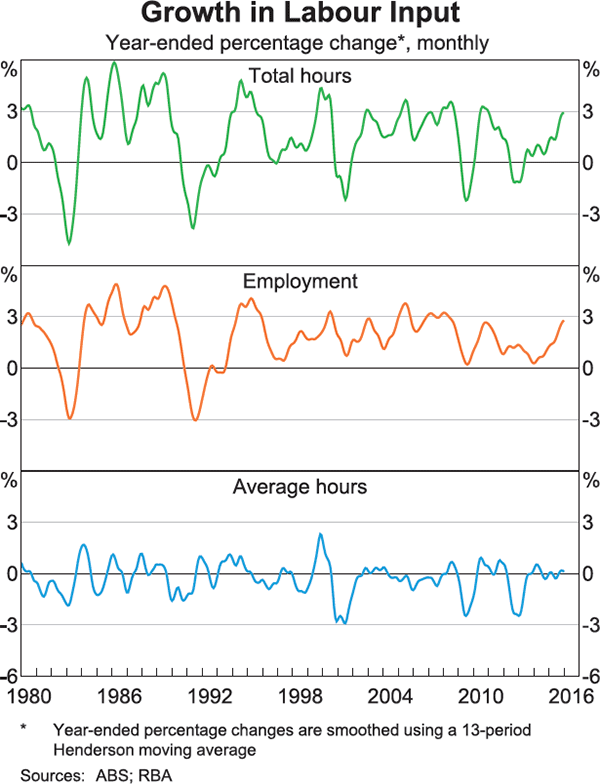
Changes in Labour Market Adjustment over Time
To analyse cyclical adjustments in the Australian labour market, the total hours worked, employment and average hours worked variables are detrended.[2] This helps to isolate changes related to the business cycle by abstracting from the trend decline in average hours worked since the late 1970s and the trend increase in employment. For example, while total employment was little changed during the 2008–09 downturn, it went from being 1.1 per cent above its trend level in September quarter 2008 to 0.6 per cent below its trend in September quarter 2009 – a cyclical change of −1¾ percentage points.
To assess whether labour market adjustment has changed over time, the cyclical decline in total hours worked is calculated for each of the past four economic ‘downturns’, as well as the contributions of employment and average hours worked to each decline (Graph 2).[3]
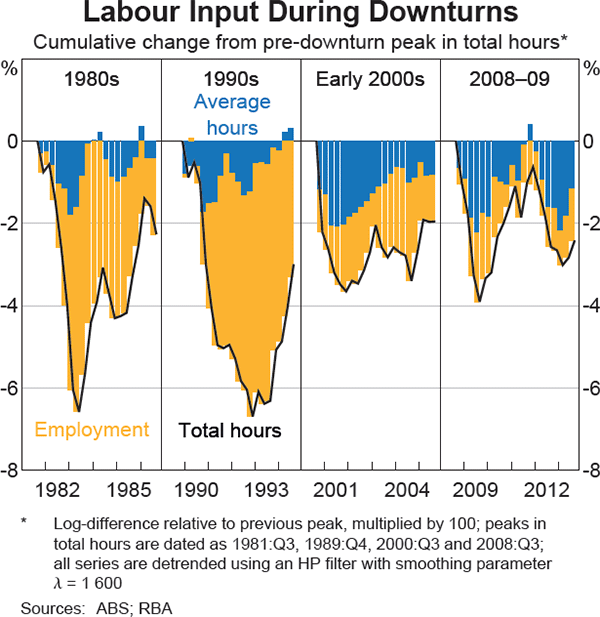
The first point evident from this analysis is that the cyclical declines in total hours worked were larger in the 1980s and 1990s recessions, reflecting the greater severity of these recessions compared with the economic downturns in the 2000s. Second, in the early stages of each downturn both employment and average hours worked contributed to the cyclical decline in total hours worked. Third, cyclical declines in average hours played a role in all four downturns – ranging from 1¾ to 2¼ per cent – although the falls were larger in the downturns in the 2000s. Finally, a larger proportion of the declines in total hours worked during the 1980s and 1990s recessions came about through reductions in employment, rather than via average hours; employment accounted for around 75 per cent of the peak-to-trough decline in total hours worked during the 1980s and 1990s recessions, compared with a contribution of only around 45 per cent in the 2000s downturns.
Decomposing the overall cyclical variation in total hours worked since 1978 – using the entire sample and taking into account the correlation between employment and average hours – provides further evidence that relatively more adjustment has occurred through average hours worked since the late 1990s (Table 1; see Appendix A for details). While estimates suggest that average hours worked have accounted for around one-quarter of the variability in total hours worked since the late 1970s, statistical tests point to a structural break in the cyclical relationship between total hours and average hours in the late 1990s (see Appendix A). The estimated contribution of average hours tripled after the late 1990s, to 61 per cent. This reflects both an increase in the variability of average hours worked and a decrease in the variability of employment over the past two decades (Graph 1).
Comparable estimates for other countries suggest that average hours worked in Australia now play a much larger role in labour market adjustment compared to the United States and Germany, but a smaller role than in Japan (Graph 3). However, Australia is the only one of these countries to have experienced a substantial pick-up in the contribution of average hours since the 1990s. Some potential explanations for this are discussed below.
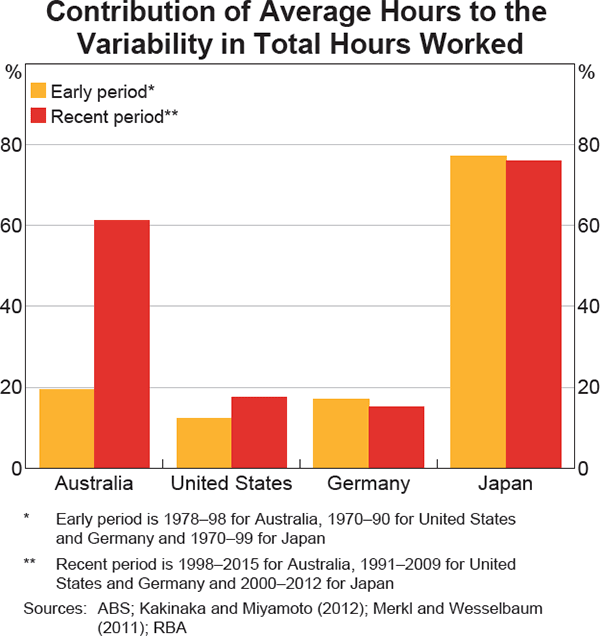
| Full sample | 1978–1998 | 1998–2015 | |
|---|---|---|---|
| Employment | 72 | 80 | 39 |
| Average hours worked | 28 | 20 | 61 |
|
(a) All variables are in logs and detrended with an HP filter (λ=1,600) Sources: ABS; RBA |
|||
Why Has More Adjustment Occurred through Average Hours?
The estimated date of the break in the late 1990s provides clues as to the source of this change in the nature of labour market adjustment. This date broadly coincides with the decline in the volatility of GDP growth in Australia. Also, this followed a period of substantial labour market reforms in the 1980s and1990s. However, because these changes overlapped, it is difficult to disentangle their separate effects. The following sections discuss these influences in more detail, along with some other explanations for the rise in the importance of average hours adjustment over recent decades, such as compositional effects.
Economic downturns in the 2000s were less severe
A plausible explanation for the higher share of average hours adjustment since the late 1990s is that the economic downturns in the 2000s were relatively short and shallow compared to the recessions in the 1980s and 1990s (Graph 4).[4] Firms are likely to prefer to adjust to weaker demand, at least in the first instance, by reducing employees' hours rather than employee numbers because of the costs and other difficulties associated with firing employees and future rehiring. Had the downturns in the 2000s been more severe, firms may have eventually needed to shed more labour. This is consistent with analysis from the Organisation for Economic Co-operation and Development (OECD) (2010) – based on 68 recession episodes in 18 countries – which concluded that adjustments to average hours tend to make the largest contribution to the decline in labour input at the early stages of a downturn. As the downturn progresses, employers increasingly resort to reducing the number of employees. In each of the downturns shown in Graph 2, the cyclical decline in average hours accounted for around half of the adjustment during the first year of the downturn. But for the deeper recessions of the 1980s and 1990s, employment became the dominant source of adjustment as weak demand conditions persisted.[5]
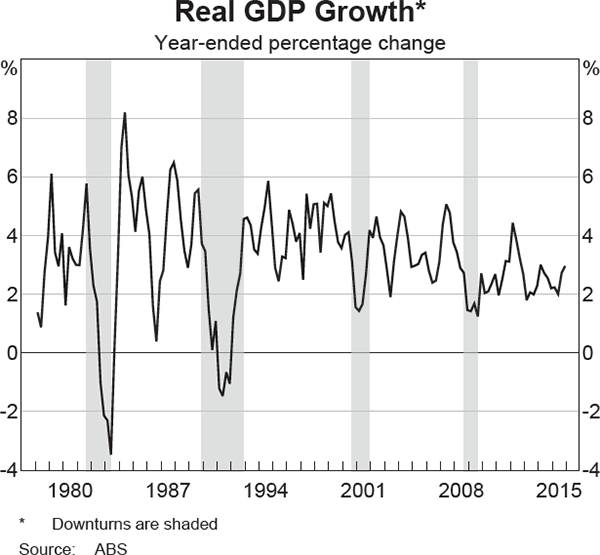
The lower severity of downturns in Australia in the 2000s may help explain why it was the only country shown in Graph 3 to experience a large increase in the contribution of average hours worked. The volatility of Australian output – measured by the standard deviation of year-ended growth in real GDP – more than halved between 1978–98 and 1999–2015. In contrast, the volatility of output in the other countries was broadly unchanged, because these countries experienced much deeper downturns in the 2000s.
One qualification to this argument is that economic theory suggests that the decision about whether to adjust via employment or hours is influenced by both current and expected demand conditions. Thus, if firms expect a deep downturn in demand, they may be more likely to shed labour pre-emptively rather than adjust the working hours of their staff. While the 2008–09 downturn in Australia turned out to be less severe than those in the 1980s and 1990s, at the time there were widespread expectations that demand conditions would deteriorate to a similar extent to those earlier recessions (see, for example, RBA (2009)). Notwithstanding these expectations, there are a number of possible reasons why firms did not engage in more adjustment through redundancies in this episode:
- While future demand was expected to be very weak, current demand conditions at the time were not especially weak.
- The labour market was very tight in the lead-up to the 2008–09 downturn, with the unemployment rate falling to around 4 per cent and firms reporting that it was difficult to find suitable labour (Graph 5; Plumb, Baker and Spence (2010)). Given this, when growth in demand slowed, firms may have been reluctant to part with their staff to avoid the costly process of re-hiring once demand recovered.
- There was heightened uncertainty surrounding economic conditions during the 2008–09 downturn compared with previous downturns (Graph 5; Moore (2016)). In these circumstances, theory suggests that firms will be less inclined to make investment decisions that are difficult or costly to reverse, including either hiring or firing workers.
- Workers were very pessimistic about their future employment prospects during the 2008–09 downturn, with self-reported perceptions about future unemployment prospects rising to unprecedented levels (Graph 5). Employees therefore may have been more reluctant to leave their jobs amid concerns about being able to find new ones, and more willing than usual to negotiate over working hours and other conditions in return for job security.

Labour market deregulation and rising hiring costs
Another possible explanation for the larger contribution of average hours to labour market adjustment since the late 1990s is that the reforms to industrial relations arrangements in the late 1980s and early 1990s made it easier for firms to bargain directly with their employees over matters like wages and working hours. This may have provided firms with more scope to reduce working hours in an effort to lower labour costs while retaining employees. As noted by Borland (2011), the 2000s were the first time in which these reforms were ‘tested’ by an economic downturn.
In practice, measuring flexibility of the labour market and how it has changed over time is not straightforward. The cyclical adjustment in average hours was larger in the 2000s, which provides tentative evidence that the labour market reforms played a role; the peak-to-trough decline was 2¼ per cent in both downturns, compared with 1¾ per cent in the early 1980s and early 1990s recessions (Graph 2). However, these differences are fairly modest.
The cost of terminating employment and the cost of screening and training new employees can also affect the nature of labour market adjustment. If firing or hiring costs are high, firms may be more inclined to respond to weaker demand conditions by decreasing the hours worked by existing staff. The average employment termination payment in Australia was nearly $14,000 in 2012/13, or 25 per cent of an average annual salary.[6] Broader measures, such as the OECD's Employment Protection Legislation (EPL) index, suggest that firing costs in Australia are lower than in most European countries, although higher than in the United States where employment protection is relatively limited.[7] However, these indicators showed little change between the mid 1980s and late 2000s for Australia, so it is unlikely that changes in firing costs have been a significant driver of changes in the nature of labour market adjustment.
In terms of hiring costs, the cost of screening and training labour is likely to have risen over time, given the increase in the number of jobs requiring specialist skills and training (Faccini and Hackworth 2010). Hiring costs are particularly high during periods of labour market tightness, since firms face higher search costs to fill vacant jobs. This might suggest that higher hiring costs can explain part of the increase in the contribution of average hours adjustment over time. However, it cannot explain why average hours adjustments have become more important in Australia but not in other advanced economies, since these countries are also likely to have seen an increase in the cost of screening and training labour.
Changes in the composition of employment
Average hours worked are affected not just by changes in the hours of workers in given jobs, but also by changes in the composition of employment between jobs involving long hours of work and jobs involving fewer hours. Falls in average hours worked could reflect changes in the industry composition of the economy during a recession. For example, if industries with longer working hours incur relatively more job losses during an economic downturn, this will contribute to a decline in overall average hours worked. Thus, another possible explanation for larger adjustments in average hours worked since the late 1990s is that compositional effects were larger than in the earlier period.
To estimate whether compositional changes have played a role, deviations in average hours worked can be decomposed into two effects (Graph 6; see Appendix B for details):
- A ‘composition effect’, which is the change in average hours worked owing to shifts in different categories of employment, while holding hours unchanged within each category. Within-category hours are kept at their August 2008 levels, and the categories include age group, gender, industry and occupation of employment, marital status and part-time and full-time employment status.
- A ‘within effect’, which captures changes in average hours worked within each category of employment; for example, a fall in average hours worked by employees within the manufacturing sector or a fall in average hours worked within part-time employment.
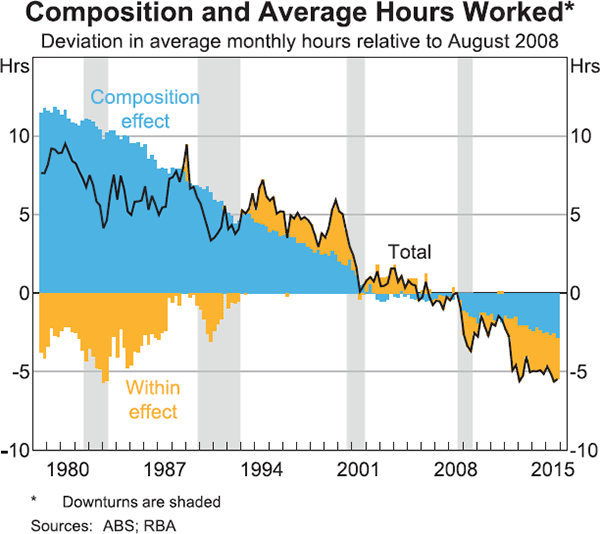
The decline in average hours since the late 1970s is entirely due to longer-run changes in the composition of employment. In particular, part-time employment has grown rapidly relative to full-time employment. However, during downturns, the primary driver of shifts in average hours is changes in average hours worked within categories, rather than changes in the composition of employment.[8] The ‘within effect’ contributed more than two-thirds of the peak-to-trough decline in average hours worked in the 1980s and 1990s recessions and more than half in the 2000s downturns. While compositional effects were relatively more important in the 2000s – and therefore may account for some of the increased contribution of average hours adjustments – they do not appear to have been the main driver.
Greater insights into the within-job shift to shorter working hours during downturns can be gleaned by looking at the individual-level data underlying the ABS's Labour Force Survey (LFS). The main benefit of these data is that they are longitudinal in nature, meaning that individual workers can be tracked over the period of time during which they remain in the sample to see if they had their hours reduced. The main disadvantage of these data is that they are only available for the period 2008 to 2010, meaning that analysis is restricted to the most recent downturn.
Bishop, Gustafsson and Plumb (forthcoming) analyse the LFS individual-level data and find that the main driver of the decline in average hours during the 2008–09 downturn was a reduction in hours worked by workers who remained in the same job. Compositional changes – which the authors define more broadly to also include the churn of workers between jobs in the same industry and occupation – accounted for at most one-half of the overall fall in average hours worked during the downturn, and probably less. This finding is consistent with the idea that, where possible, firms made adjustments via reduced hours, rather than by firing employees. The reductions in hours worked for those staying in the same job were largest for workers in industries that had experienced skills shortages prior to the downturn. Firms in these industries may have been ‘overutilising’ staff prior to the downturn, and started to reduce hours to more normal levels as demand eased. As discussed earlier, firms may also have been reluctant to let go of skilled workers because labour had been so difficult to source just prior to the downturn.
Have Average Hours Worked Become More Sensitive to the Cycle?
The analysis in the previous sections suggests that the less severe nature of downturns in the 2000s, labour market deregulation and increases in hiring costs may all help explain the increased role of changes in average hours in Australian labour market adjustment since the 1990s. However, it is not possible to distinguish between these explanations using statistical techniques given the available data, as all imply that changes in average hours worked have become more sensitive to changes in the business cycle since the late 1990s.
- If average hours adjust more during the initial stages of a downturn and only up to a point, then econometric models would tend to find that average hours worked are relatively more responsive to changes in GDP during smaller downturns (and relatively less responsive during larger downturns, in which more adjustment occurs through employment). Since the downturns in Australia were less severe after the late 1990s, this suggests that the relative sensitivity of average hours worked to a given change in GDP should have risen in recent decades.
- Labour market reforms and rising hiring costs suggest that the sensitivity of average hours to a given change in GDP should have increased (or that the sensitivity of employment has decreased, or both). Given that many important labour market reforms had been completed by the late 1990s, the relative sensitivity of average hours worked should have increased after the late 1990s.
Nevertheless, it is useful to test whether at least one of these explanations contributed to the changes in labour market adjustment in Australia in recent decades. One way of exploring whether labour market variables have become more or less sensitive to the cycle is to estimate a Vector Autoregression (VAR) model, which captures the dynamic relationships between GDP, average hours worked and employment.[9] The response of labour market variables to a positive 1 per cent ‘shock’ to GDP is shown in Graph 7. The left- and right-hand panels show the impulse response functions (IRFs) estimated over the 1978–98 and 1998–2015 sub-samples, respectively, along with the +/−2 standard error bands. Comparing the left- and right-hand panel reveals whether the relationship between GDP and each variable changed over time.
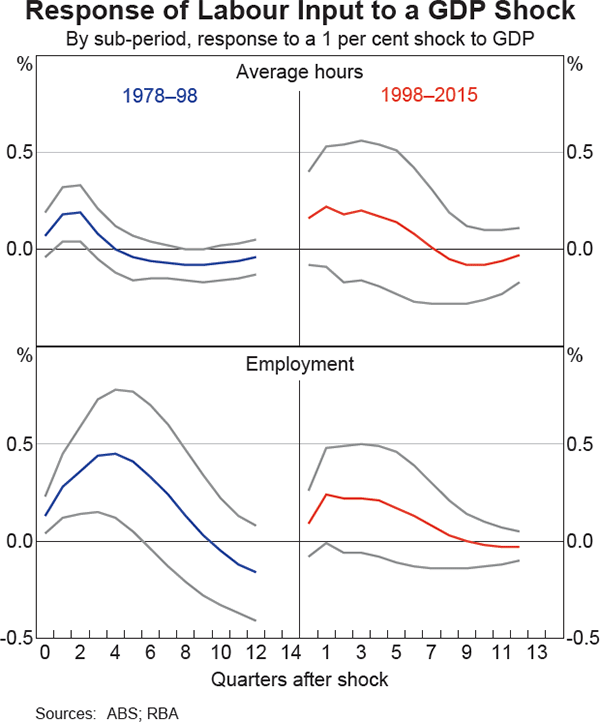
In general, the volatile and noisy nature of measures of average hours worked makes it difficult to find empirical evidence of relationships between average hours worked and the other variables that should, in theory, be related to it. That said, the VAR model provides some tentative evidence that average hours became more sensitive to the cycle after 1998, although the difference between the IRFs in the two sub-periods is not statistically significant. The model also suggests that the responsiveness of employment declined after 1998, although again the difference between the sub-periods is not statistically significant. Thus, while it is difficult to draw any firm conclusions from this model, it seems likely that either the reduction in the severity of downturns or labour market reforms (or both) explains at least part of the greater contribution of average hours to labour market adjustment in recent decades.
Conclusion
Since the late 1990s, a larger share of cyclical labour market adjustment in Australia has come about via changes in average hours worked, as opposed to changes in employment. Much of this is likely to reflect that the economic downturns in the 2000s were relatively short and shallow compared to the recessions in the 1980s and 1990s. Had these later downturns been more severe, firms may eventually have needed to shed more workers than they did. In other words, both employment and average hours tend to adjust in the early stages of a downturn, but relatively more adjustment occurs through employment as the downturn persists and becomes more severe. It is also possible that labour market reforms over recent decades have provided firms with more scope to reduce labour input by reducing working hours and wage growth rather than by redundancies.
Appendix A
The estimates in Table 1 are based on the decomposition outlined in Merkl and Wesselbaum (2011). The contribution of average hours to cyclical adjustment in total hours is given by θA ≡ Cov(tothrst,avhrst)/Var(tothrst), where tothrstot and avhrst are total hours worked and average hours worked, respectively. All variables are in logs and detrended using an HP filter with smoothing parameter λ = 1,600. The estimate gives the proportion of variation in total hours that derives from average hours, both directly and indirectly through its correlation with employment. Similarly, the contribution of employment to cyclical adjustment in total hours is given by θE ≡Cov(tothrst,empt)/Var(tothrst), where empt is employment. These estimates are equivalent to the slope coefficients in simple ordinary least squares (OLS) regressions of average hours on total hours and employment on total hours, respectively.
Using alternative methods to detrend the data does not affect the main conclusions. Using four-quarter log differences rather than the HP filter does not have a material effect on the results. Using one-quarter log differences suggests a larger role for average hours adjustments prior to 1998 relative to the other detrending methods, although this is likely to reflect the high quarter-to-quarter volatility in the average hours data.
OLS estimates of θA and θE might be biased due to the mechanical relationship between the dependent variable and the regressor. To obtain a consistent estimator of the parameters, an instrument for total hours can be used; in this case, two lags of HP-filtered real GDP were chosen. Similar to the OLS estimates, the two-stage least squares estimates suggest that the contribution of average hours increased substantially after the late 1990s.
The regression framework also allows us to perform the Quandt-Andrews structural break test for an unknown break point. The test is for a break in the coefficient in the regression equation, although also allowing for a break in the constant does not change the result. Using a Chow test, there is evidence of a statistically significant break in 1998:Q2 when using alternative detrending methods such as one-quarter-ended or four-quarter-ended log differences, rather than the HP filter.
Appendix B
Rather than considering all potentially relevant compositional factors individually (e.g. age, gender, industry, part-time/full-time), a multiple regression-based approach can be used to consider the combined effect of these variables simultaneously. This approach can be used to estimate the effect of compositional shifts in employment on the change in average hours worked between August 2008 and any given quarter since the late 1970s.
The first step is to estimate a regression using data on individual workers from the August 2008 cross-section of the LFS:
where Hi,2008 is actual hours worked per month by individual i, Xi,2008 is a vector of explanatory variables and β is the vector of coefficients to be estimated. The regression is weighted using the ABS's population weights. The explanatory variables include: age group (11 dummies), gender (1 dummy), industry (18 dummies), occupation (7 dummies), marital status (1 dummy), whether the employee was born in Australia or another main English or non-main English-speaking country (2 dummies), and whether the worker is an employee, employer or self-employed (2 dummies).
The contribution of compositional change to the overall change in average hours between August 2008 and quarter t is given by
where  is a vector of estimated coefficients from the August 2008 cross-section of the
LFS
is a vector of estimated coefficients from the August 2008 cross-section of the
LFS  and
and  are the means across individuals of the observed values in August 2008 and quarter
t, respectively. This is referred to as the ‘composition
effect’. While LFS micro data are not currently available on a consistent
basis prior to 2008 or after 2010,
are the means across individuals of the observed values in August 2008 and quarter
t, respectively. This is referred to as the ‘composition
effect’. While LFS micro data are not currently available on a consistent
basis prior to 2008 or after 2010,  is available from
the published LFS employment time series data. The ‘composition effect’
measures the change in average hours that would have occurred between August
2008 and quarter
t if all within-category (e.g. within-industry and within-age group)
hours had remained constant at their August 2008 levels. The difference
between the actual change in average hours and the ‘composition effect’
measures the effect on average hours of changes in hours within categories
of employment, holding composition
constant.[10]
In this article, this is referred to as the ‘within effect’.
is available from
the published LFS employment time series data. The ‘composition effect’
measures the change in average hours that would have occurred between August
2008 and quarter
t if all within-category (e.g. within-industry and within-age group)
hours had remained constant at their August 2008 levels. The difference
between the actual change in average hours and the ‘composition effect’
measures the effect on average hours of changes in hours within categories
of employment, holding composition
constant.[10]
In this article, this is referred to as the ‘within effect’.
Footnotes
The authors are from Economic Group. [*]
In this article, total hours worked is the Australian Bureau of Statistics' (ABS) measure of ‘aggregate monthly hours worked’ and average hours worked is implied from total hours and employment. [1]
The series are detrended using an HP filter with smoothing parameter λ = 1,600. Estimates of the relative cyclical adjustment between employment and average hours are not particularly sensitive to the choice of smoothing parameter. [2]
The term ‘downturn’ is used in this article to refer to the recessions in the early 1980s and the early 1990s, and the growth slowdowns in the early 2000s and late 2000s. [3]
The downturn periods shaded in Graphs 4, 5 and 6 are based on the peak-to-trough decline in (detrended) total hours worked. [4]
It is also possible that the downturns in the 2000s were less severe because more adjustment occurred through average hours. However, examining this hypothesis is beyond the scope of this article. [5]
These calculations are based on the total value of employment termination payments (ETP) and income from salary or wages from the Australian Taxation Office (ATO 2015). The value of ETP measures the taxable component of payments related to resignation, dismissal, redundancy, retirement or death. [6]
The EPL index is available from the mid 1980s and covers a range of termination cost indicators including dismissal costs, procedural inconveniences (i.e. ‘red tape’), notification requirements and the potential compensation if a dismissal is found to be unfair. [7]
The ‘within effect’ is not the same as the ‘cyclical’ average hours worked series derived earlier using the HP filter. The ‘within effect’ captures all changes in average hours that are not explained by compositional changes in employment. In contrast, the ‘cyclical’ change in average hours captures all deviations of average hours from trend, due to both cyclical ‘within effects’ and cyclical ‘composition effects’. Nonetheless, the two series are highly correlated, reflecting the limited contribution of compositional effects to cyclical movements in average hours. [8]
The results in Graph 7 are from a VAR(3) model with three variables, ordered as follows: real GDP, average hours worked and employment. Following RBA (2014), this ordering assumes that GDP is the most exogenous variable in the system, with the ordering of the other variables reflecting the relative speed at which they are assumed to respond to a shock to GDP. In turn, GDP is assumed not to respond contemporaneously to any of the labour market variables, but may respond with a lag. All variables in the VAR are in logs and detrended with an HP filter (λ=1,600). The results from VAR models can be sensitive to the variables included and the structure of the VAR, so the results shown here should be considered as illustrative only. [9]
This approach is equivalent to estimating an Oaxaca decomposition between August 2008 and every other quarter t. However, rather than estimating a separate regression for every quarter in time (along with August 2008) it simply treats any difference between the actual change and the composition effect as the ‘unexplained (or within) effect’. [10]
References
ATO (Australian Taxation Office) (2015), ‘Taxation Statistics 2012–13, Individuals Table 1’, online, date accessed 1 February 2016, Available at <https://www.ato.gov.au/About-ATO/Research-and-statistics/In-detail/Tax-statistics/Taxation-statistics-2012-13/?anchor=indiv_detailed#indiv_detailed>.
Bishop J, Gustafsson L and M Plumb (forthcoming), ‘Losing Jobs or Losing Hours?: Cyclical Labour Market Adjustment in Australia’, RBA Research Discussion Paper.
Borland J (2011), ‘The Australian Labour Market in the 2000s: The Quiet Decade’, in H Gerard and J Kearns (eds), The Australian Economy in the 2000s, Proceedings of a Conference, Reserve Bank of Australia, Sydney, pp 165–218.
Faccini R and C Hackworth (2010), ‘Changes in Output, Employment and Wages during Recessions in the United Kingdom’, Bank of England Quarterly Bulletin, Q1, pp 43–50.
Kakinaka M and H Miyamoto (2012), ‘Extensive vs. Intensive Margin in Japan’, International University of Japan Economics & Management Series Working Paper EMS-2012-14.
Merkl C and D Wesselbaum (2011), ‘Extensive vs. Intensive Margin in Germany and the United States: Any Differences?’, Applied Economics Letters, 18(9), pp 805–808.
Moore (2016), ‘Measuring Economic Uncertainty and Its Effects’, RBA Research Discussion Paper No 2016-01.
OECD (Organisation for Economic Co-operation and Development) (2010), ‘Moving Beyond the Jobs Crisis’, OECD Employment Outlook 2010, Chapter 1, pp 15–102.
Plumb M, Baker M and G Spence (2010), ‘The Labour Market During the 2008–2009 Downturn’, RBA Bulletin, March, pp 1–6.
RBA (Reserve Bank of Australia) (2009), ‘Economic Outlook’, Statement on Monetary Policy, May, pp 67–71.
RBA (2014), ‘Box B: Lags from Activity to the Labour Market’, Statement on Monetary Policy, May, pp 39–42.

